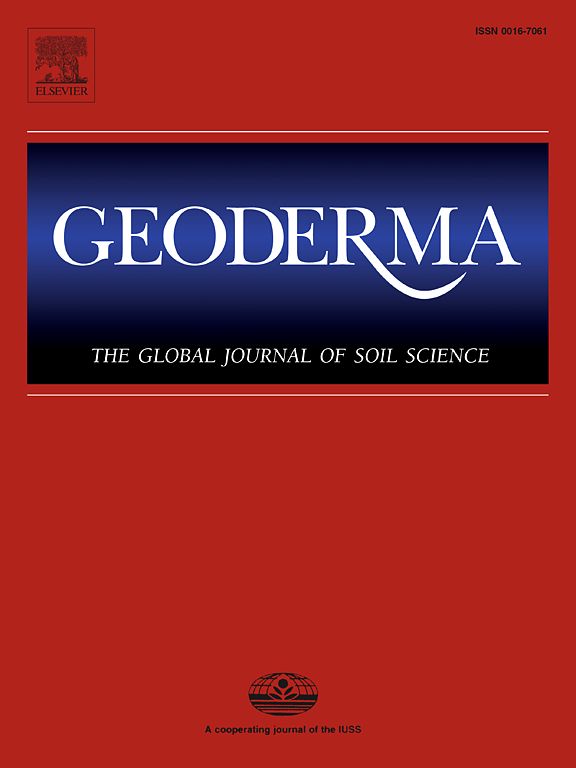土壤新陈代谢紊乱导致再植疾病(植物-土壤的种内负反馈):人参种植 20 年后土壤影响实验的启示
IF 5.6
1区 农林科学
Q1 SOIL SCIENCE
引用次数: 0
摘要
移栽病害(RDs)是植物与土壤之间的种内负反馈,通常源于养分缺乏、等位病害或病原体积累。然而,某些作物的返青病持续时间较长,其原因仍不清楚。我们利用多组学和生物测定方法,研究了代表作物轮作恢复的土壤时空序列中 1 年、10 年和 20 年的板蓝根 RD。与没有人参种植历史的土壤相比,我们发现了 110 个与 RD 相关的重要潜在因子,令人惊讶的是,其中 53 个因子在 20 年后仍未恢复。土壤的 pH 值和有机养分(氨基酸、碳水化合物和醛糖醇)、等位基因促进代谢物(酚酸、胺、吡啶等)、有益细菌(Sphingomonas、Burkholderia-Caballeronia-Paraburkholderia 和 Terrabacter)和真菌(Acremonium、Penicillium 和 Naganishia)的水平都有所下降,而等位化学物质(丙酮酸和脂肪酸)的水平则有所上升。所有代谢途径的表达都明显下调,只有脂肪酸相关代谢途径的表达上调。我们证实,有机养分水平的降低和等位化学物质水平的升高会影响五步蛇的生长。通过网络分析,土壤代谢因素而非微生物因素占主导地位。总之,我们发现养分水平以及代谢和微生物因素的整体变化是造成短期 RD(1-10 年)持续的原因,而长期 RD(20 年后)主要是土壤代谢物水平和途径紊乱造成的。这项研究将有助于加深我们对 RD 与珍贵植物的土壤遗留效应导致 RD 影响因素潜在变化之间关系的理解,并为有效改善土壤质量提供理论指导。本文章由计算机程序翻译,如有差异,请以英文原文为准。

Soil metabolic disturbance drives replant disease (intraspecific negative plant–soil feedback): Insights from an experiment examining soil impacts up to 20 years after a ginseng crop
Replant diseases (RDs), intraspecific negative plant–soil feedback, often stem from nutrient deficiency, allelopathy, or pathogen accumulation. However, the RDs of certain crops are long-lasting and their causes remain unknown. We examined Panax quinquefolius RD in a space-for-time soil sequence representing crop rotation restoration over 1, 10, and 20 years using multiomics and bioassays. Compared with the soils with no ginseng cultivation history, we found 110 significant potential factors related to RD, surprisingly, 53 of which remained unrestored after 20 years. Soil pH and the levels of organic nutrients (amino acids, carbohydrates, and alditols), allelopathic-promoting metabolites (phenolic acids, amines, pyridines, etc.), and beneficial bacteria (Sphingomonas, Burkholderia-Caballeronia-Paraburkholderia, and Terrabacter) and fungi (Acremonium, Penicillium, and Naganishia) decreased, while the levels of allelochemicals (pyruvic and fatty acids) increased. The expression of all metabolic pathways was significantly down-regulated, with the exception of the up-regulated fatty acid-related metabolic pathways. We confirmed that decreased organic nutrient levels and increased levels of allelochemicals impaired P. quinquefolius growth. Soil metabolic factors rather than microbial factors were dominant by network analysis. In conclusion, we found that the overall changes in nutrient levels and metabolic and microbial factors contributed to short-term RD (1–10 year) persistence, whereas long-term RD (after 20 years) primarily resulted from disordered soil metabolite levels and pathways. This research will help deepen our understanding of the relationship between RD and potential changes in the factors influencing RD that are caused by soil legacy effects of valuable plants and provide theoretical guidance for effective soil quality improvement.
求助全文
通过发布文献求助,成功后即可免费获取论文全文。
去求助
来源期刊

Geoderma
农林科学-土壤科学
CiteScore
11.80
自引率
6.60%
发文量
597
审稿时长
58 days
期刊介绍:
Geoderma - the global journal of soil science - welcomes authors, readers and soil research from all parts of the world, encourages worldwide soil studies, and embraces all aspects of soil science and its associated pedagogy. The journal particularly welcomes interdisciplinary work focusing on dynamic soil processes and functions across space and time.
 求助内容:
求助内容: 应助结果提醒方式:
应助结果提醒方式:


